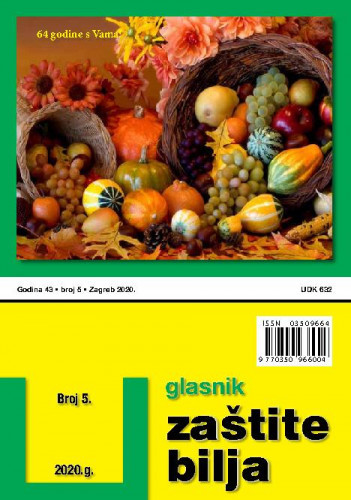Bor (B) je esencijalni biogeni element neophodan za rast i razvoj masline, a nedostatak B općenito se smatra jednim od najčešćih nedostataka mikroelemenata u maslinarstvu. Iako nedostatak B može dovesti do promjene koncentracije različitih fenolnih spojeva u listu masline utjecaj ishranjenosti masline B na fenolni profil lista udomaćenih sorata masline nije dovoljno istražen. Stoga, cilj ovog istraživanja bio je utvrditi utjecaj primjene hranive otopine s (B+) (30 μM B) ili bez (B-) (0 μM B) bora na fenolni profil lista masline (Olea europaea L.) sorte 'Istarska bjelica'. Pokus je postavljen kao slučajni blokni raspored u četiri ponavljanja na ukupno 40 sadnica masline sorte 'Istarska bjelica'. Uzorkovanje lista provedeno je nakon 60 dana od početka pokusa. Koncentracija B u listu masline bila je značajno veća u B+ tretmanu, dok su utvrđene koncentracije ukupnih fenola i verbaskozida u listu masline bile značajno veće u B- tretmanu. Gnojidba B nije značajno utjecala na koncentraciju ostalih fenolnih spojeva. Značajno veća koncentracija ukupnih fenola i verbaskozida u listu sorte 'Istarska bjelica' kod B- tretmana može se povezati s fiziološkim odgovorom biljke na nedostatak B.; Boron (B) is an essential nutrient for growth and development of olive, whereas B deficiency is among the most common micronutrient disorders in olive production. Boron deficiency contributes changes in the concentration of different phenolic compounds in olive leaves, the impact of B nutrition on the phenolic leaf profile of autochthonous olive varieties is mainly unknown. This study aimed to investigate the impact of nutrient solutions, with (B+) and without (B-) boron addition, on the phenolic profile in olive leaves of cultivar ‘Istarska bjelica’. The experiment was set up in random block design in four repetitions, on 40 olive plantlets of cultivar ‘Istarska bjelica’. Olive leaves were sampled 60 days after the beginning of the experiment. Boron concentration in olive leaves was significantly higher in the B+ treatment, whereas total phenolic content and verbascoside concentration were significantly higher in the olive leaves of the B- treatment. Boron nutrition had no significant impact on other phenolic compounds. A significantly higher total phenolic content and verbascoside concentration, determined in olive leaves of cultivar ‘Istarska bjelica’, indicate the relation between physiological plant response and B deficiency.
Fenolni profil lista masline sorte 'Istarska bjelica' pri različitoj koncentraciji bora u hranivoj otopini / Kristina Grozić, Igor Pasković, Paula Žurga, Valerija Majetić Germek, Igor Lukić, Mia Brkljača, Branimir Urlić, Janja Klanjac, Šime Marcelić, Dean Ban, Joško Kaliterna, Mirjana Herak Ćustić, Smiljana Goreta Ban.
Sažetak

 Glasnik zaštite bilja : 43,5(2020) / glavni urednik Katarina Lučić.
Glasnik zaštite bilja : 43,5(2020) / glavni urednik Katarina Lučić.